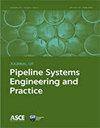基于拓扑的配水系统抗震性能评价与恢复分析的弹性指标
IF 1.7
4区 工程技术
Q3 ENGINEERING, CIVIL
Journal of Pipeline Systems Engineering and Practice
Pub Date : 2023-02-01
DOI:10.1061/jpsea2.pseng-1303
引用次数: 1
摘要
供水系统(WDSs)需要具有抵御地震灾害的能力,以确保社区在地震后迅速恢复。基于拓扑的弹性度量通常用于确定wds的系统级性能。然而,现有的基于拓扑的弹性指标无法准确估计wds的抗震性能,因为它们没有考虑指标中管道的脆弱性。该研究调整了现有的拓扑度量,并开发了一种新的基于边缘之间的拓扑度量,用于评估复杂配水网络的地震恢复能力。采用基于最小割集(MCS)的系统可靠性、拓扑弹性度量(TRM)、改进的TRM和新开发的基于边缘之间的TRM四种性能度量来比较wds的系统级性能。将这些指标应用于四个具有独特特征的wds(即Anytown, New York Tunnel,吉林和Bellingham wds),以验证其在估计wds对地震危害的抗震性能方面的有效性。这些应用结果表明,与现有方法相比,所提出的TRM可以用于确定地震后管道的抗震性能和功能,精度可接受。虽然基于拓扑的弹性分析提供了有关系统级功能的信息,但确定受损wds的最佳恢复顺序以在恢复过程中最大限度地发挥功能也至关重要。为此,提出了一种易于使用的修复策略,以确定基于修复指标的最优修复顺序。针对地震造成的Anytown WDS损坏的恢复过程,对最优恢复策略进行了测试,结果表明,采用该最优恢复策略,系统功能恢复最快。本文章由计算机程序翻译,如有差异,请以英文原文为准。
Topology-Based Resilience Metrics for Seismic Performance Evaluation and Recovery Analysis of Water Distribution Systems
Water distribution systems (WDSs) need to be resilient against seismic hazards to ensure rapid recovery of the community following an earthquake. Topology-based resilience metrics are often used to determine the system-level performance of WDSs. However, existing topology-based resilience metrics are unable to estimate seismic performance of WDSs accurately because they do not account for the vulnerability of pipelines in the metrics. This study tailored an existing topological metric and developed a new edge-betweenness-based topological metric for evaluating the seismic resilience of a complex water distribution network. System-level performance of WDSs is compared using four performance measures including minimum cut set (MCS)–based system reliability, topological resilience metric (TRM), modified TRM, and the newly developed edge-betweenness-based TRM. These metrics were applied for four WDSs (i.e., Anytown, New York Tunnel, Jilin, and Bellingham WDSs) with unique characteristics to validate their effectiveness in estimating the seismic performance of WDSs against seismic hazards. The outcomes of these applications show that the proposed TRM can be used to determine pipelines’ seismic performance and functionality after an earthquake with an acceptable accuracy compared with existing approaches. While the topology-based resilience analysis provides information about system-level functionality, it is also vital to determine an optimal recovery sequence for damaged WDSs to maximize the functionality during the recovery process. Therefore, an easy-to-use recovery strategy is proposed to determine the optimal recovery sequence based on a repair index. The optimal recovery strategy was tested for the recovery procedure for the damaged Anytown WDS due to an earthquake, and outcomes show the system functionality is restored quickest using the proposed optimal recovery strategy.
求助全文
通过发布文献求助,成功后即可免费获取论文全文。
去求助
来源期刊

Journal of Pipeline Systems Engineering and Practice
ENGINEERING, CIVIL-WATER RESOURCES
CiteScore
3.80
自引率
10.00%
发文量
82
期刊介绍:
The Journal of Pipeline Systems Engineering and Practice is a professional, authoritative technical resource that reports on a broad range of topics pertaining to the planning, engineering, design, construction, renewal, safety, operation and maintenance, asset management, environmental aspects, and sustainability of pipeline systems.
An important technical reference for researchers and practitioners from academia, industry, and government, it presents in-depth information on water distribution and transmission systems, wastewater collection systems (gravity and force mains), storm sewers and drainage structures/culverts, oil, gas, industrial, slurry, pneumatic and capsule pipelines, as well as conduit applications for power and communication cables.
 求助内容:
求助内容: 应助结果提醒方式:
应助结果提醒方式:


